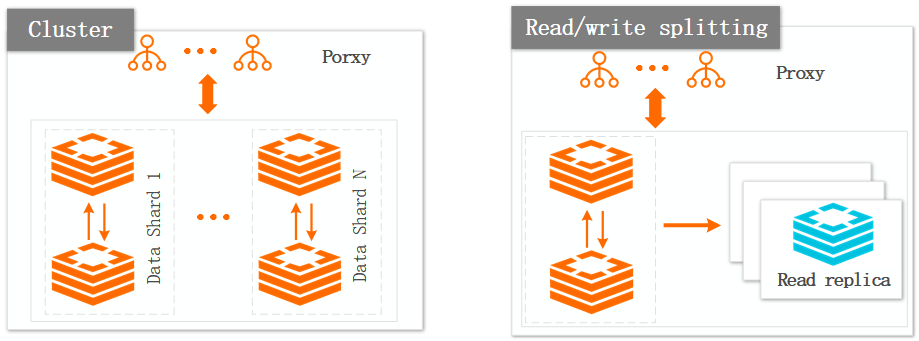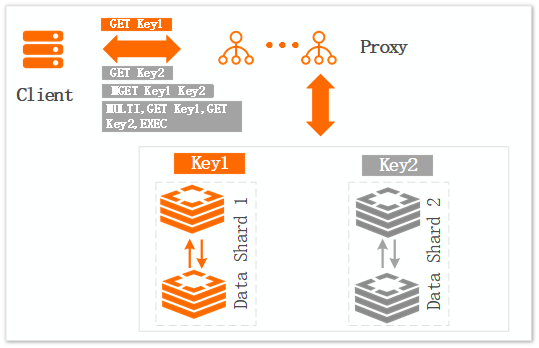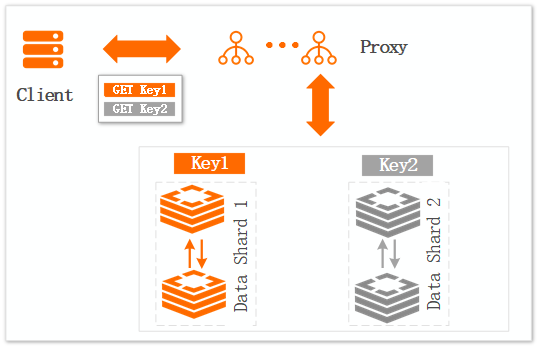Tair cluster instances and read/write splitting instances use proxy nodes to route commands, balance loads, and perform failovers. Proxy nodes can help simplify the client-side logic while providing support for advanced features such as handling connections to multiple databases and caching hotkey data. Gaining a solid understanding of how proxy nodes route commands and handle specific commands empowers you to design more efficient business systems.
Overview of proxy nodes
Figure 1. Architectures of cluster instances and read/write splitting instances 
A proxy node is a component that runs in the standalone architecture in a Tair instance. Proxy nodes do not occupy resources of data shards. A Tair instance uses multiple proxy nodes to balance loads and perform failovers.
Feature | Description |
Architecture transformation | Proxy nodes allow you to use a cluster instance in the same manner as you use a standard instance. Proxy nodes support multi-key operations across different hash slots for commands such as DEL, EXISTS, MGET, MSET, SDIFF, and UNLINK. For more information, see Limits on commands supported by cluster instances and read/write splitting instances. If your business requirements grow beyond the capabilities that can be provided by a standard instance, you can migrate the data of the standard instance to a cluster instance that has proxy nodes without having to modify code to reduce costs. |
Load balancing and command routing | Proxy nodes establish persistent connections with backend data shards to balance loads and route commands. For more information, see Routing methods of proxy nodes. |
Management of traffic to read replicas | Proxy nodes monitor the status of each read replica in real time. If a read replica is in one of the following states, proxy nodes stop routing traffic to the read replica:
|
Hotkey data caching | After you enable the proxy query cache feature, proxy nodes cache the request and response data of hotkeys. If a proxy node receives the same request multiple times within the validity period of the cache, the proxy node returns the cached result directly to the client without interacting with backend data shards. This prevents data access skew caused by a large number of read requests for hotkeys. For more information, see Use proxy query cache to address issues caused by hotkeys. Note This feature is available only for Tair DRAM-based and persistent memory-optimized instances. |
Support for multiple databases | In cluster mode, multiple databases are not supported by open source Redis or Redis Cluster clients. In this case, only the default database Note If you use the StackExchange.Redis client, use StackExchange.Redis 2.7.20 or later. Otherwise, an error occurs. For more information, see StackExchange.Redis update notice. |
As the proxy technology evolves, the number of proxy nodes in a cluster instance does not solely determine the processing capacity of proxy nodes. Alibaba Cloud ensures that the allocation and configuration of proxy nodes meet the requirements stated in the specifications.
Routing methods of proxy nodes
For information about commands, see Overview.
Architecture | Routing method | Description |
Cluster architecture | Basic routing method |
|
Routing method for specific commands |
| |
Read/write splitting architecture | Basic routing method |
|
Routing method for specific commands |
|
Number of connections
Typically, proxy nodes establish persistent connections with data shards to process requests. When the requests include one of the following commands, proxy nodes establish additional connections with data shards as needed. In this case, the maximum number of connections and the maximum number of new connections per second for the instance are subject to the maximum number of connections for a single data shard in direct connection mode. This is because the connections cannot be aggregated in this scenario. You can refer to your instance specifications to view the maximum number of connections for a single data shard. When you run the following commands, make sure that the number of connections to each data shard does not exceed the upper limit.
In proxy mode, Tair instances allow up to 30,000 connections to each data shard.
Blocking commands: BRPOP, BRPOPLPUSH, BLPOP, BZPOPMAX, BZPOPMIN, BLMOVE, BLMPOP, and BZMPOP.
Transaction commands: MULTI, EXEC, and WATCH.
Monitoring commands: MONITOR, IMONITOR, and RIMONITOR.
Pub/Sub commands: SUBSCRIBE, UNSUBSCRIBE, PSUBSCRIBE, PUNSUBSCRIBE, SSUBSCRIBE, and SUNSUBSCRIBE.
FAQ
Can I forward Lua scripts that perform only read operations to read replicas?
Yes, you can forward Lua scripts that perform only read operations to read replicas. However, the following requirements must be met:
A read-only account is used. For more information, see Create and manage database accounts.
The readonly_lua_route_ronode_enable parameter is set to 1 for your Tair instance. A value of 1 indicates that Lua scripts that perform only read operations are routed to read replicas. For more information, see Modify the values of parameters for an instance .
What is the difference between the proxy mode and the direct connection mode? Which mode is recommended?
We recommend that you use the proxy mode. The following items describe the difference between the proxy mode and the direct connection mode:
Proxy mode: Proxy nodes forward requests from clients to data shards. This mode provides features such as load balancing, read/write splitting, failover, proxy query cache, and persistent connection.
Direct connection mode: In this mode, you can use private endpoints to bypass proxy nodes and directly connect to backend data shards of your instance in a similar manner as you connect to an open source Redis cluster. Compared with the proxy mode, the direct connection mode eliminates the need for the use of proxy nodes to process requests. This can accelerate the response speed of Tair to some extent.
How does an abnormal data shard affect data reads and writes?
Each data shard runs in a high-availability master-replica architecture. If the master node fails, the system switches the workloads to the replica node to ensure high availability. The following table describes the impacts of abnormal data shards on data reads and writes in specific scenarios and provides optimization methods for each scenario.
Scenario
Impact and optimization
Figure 2. Commands that manage multiple keys

Impact:
The client sends four requests over four connections. If Data Shard 2 is abnormal, timeout errors are returned for the requests that are routed to Data Shard 2. The queried data is returned only for Request 1 (GET Key1).
Optimization methods:
Reduce the usage frequency of the commands that manage multiple keys such as MGET or reduce the number of keys that are managed by a request. This ensures that not all requests fail simply because a single data shard is abnormal.
Reduce the usage frequency of transaction commands or reduce the transaction size. This way, when a subtransaction fails, it does not cause the entire transaction to fail.
Figure 3. Single connection

Impact:
The client sends two requests over the same connection. If Data Shard 2 is abnormal, timeout errors are returned for Request 1 (GET Key1) and Request 2 (GET Key2). In this example, Request 1 fails because it uses the same connection as Request 2.
Optimization methods:
Minimize the use of pipelines.
Do not use clients that support only a single connection such as Lettuce. We recommend that you use clients that support connection pools such as Jedis. If you use Jedis, you must configure a reasonable timeout period and connection pool size. For more information about Jedis, see Use a client to connect to a Tair instance.